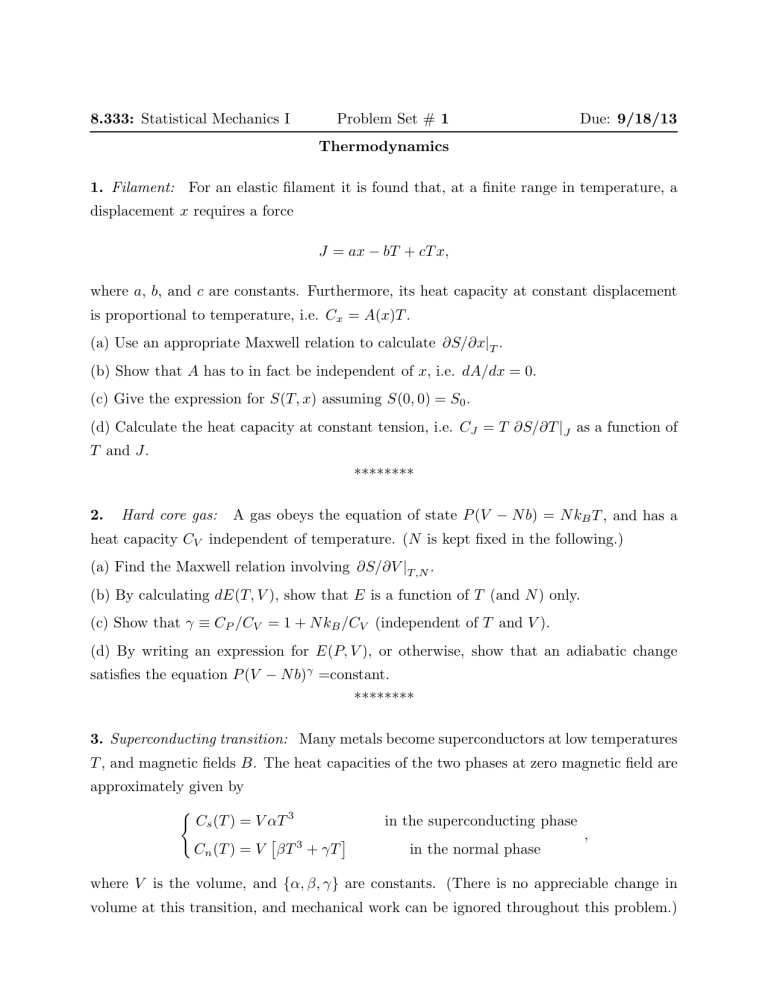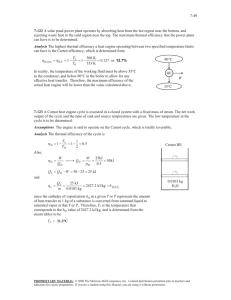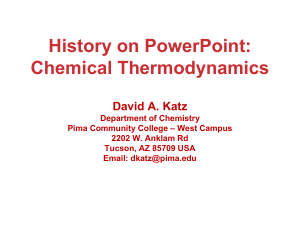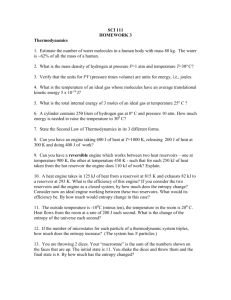Document 13470510

8.333: Statistical Mechanics I Problem Set # 1
Thermodynamics
Due: 9/18/13
1.
Filament: For an elastic filament it is found that, at a finite range in temperature, a displacement x requires a force
J = ax − bT + cT x, where a , b , and c are constants. Furthermore, its heat capacity at constant displacement is proportional to temperature, i.e. C x
= A ( x ) T .
(a) Use an appropriate Maxwell relation to calculate ∂S/∂x |
T
.
(b) Show that A has to in fact be independent of x , i.e. dA/dx = 0.
(c) Give the expression for S ( T, x ) assuming S (0 , 0) = S
0
.
(d) Calculate the heat capacity at constant tension, i.e. C
J
= T ∂S/∂T |
J
T and J . as a function of
********
2.
Hard core gas: A gas obeys the equation of state P ( V − N b ) = N k
B
T , and has a heat capacity C
V independent of temperature. ( N is kept fixed in the following.)
(a) Find the Maxwell relation involving ∂S/∂V |
T,N
.
(b) By calculating dE ( T, V ), show that E is a function of T (and N ) only.
(c) Show that γ ≡ C
P
/C
V
= 1 + N k
B
/C
V
(independent of T and V ).
(d) By writing an expression for E ( P, V ), or otherwise, show that an adiabatic change satisfies the equation P ( V − N b ) γ =constant.
********
3.
Superconducting transition: Many metals become superconductors at low temperatures
T , and magnetic fields B . The heat capacities of the two phases at zero magnetic field are approximately given by
C s
( T ) = V αT
3
C n
[ ( T ) = V βT
3
+ γT ] in the superconducting phase in the normal phase
, where V is the volume, and { α, β, γ } are constants. (There is no appreciable change in volume at this transition, and mechanical work can be ignored throughout this problem.)
(a) Calculate the entropies S s
( T ) and S n
( T ) of the two phases at zero field, using the third law of thermodynamics.
(b) Experiments indicate that there is no latent heat ( L = 0) for the transition between the normal and superconducting phases at zero field. Use this information to obtain the transition temperature T c
, as a function of α , β , and γ .
(c) At zero temperature, the electrons in the superconductor form bound Cooper pairs.
As a result, the internal energy of the superconductor is reduced by an amount V Δ, i.e.
E n
( T = 0) = E
0 and E s
( T = 0) = E
0
− V Δ for the metal and superconductor, respectively.
Calculate the internal energies of both phases at finite temperatures.
(d) By comparing the Gibbs free energies (or chemical potentials) in the two phases, obtain an expression for the energy gap Δ in terms of α , β , and γ .
(e) In the presence of a magnetic field B , inclusion of magnetic work results in dE =
T dS + BdM + µdN , where M is the magnetization. The superconducting phase is a perfect diamagnet, expelling the magnetic field from its interior, such that M s
= − V B/ (4 π ) in appropriate units. The normal metal can be regarded as approximately non-magnetic, with M n
= 0. Use this information, in conjunction with previous results, to show that the superconducting phase becomes normal for magnetic fields larger than
�
B c
( T ) = B
0
1 −
T 2 �
,
T c
2 giving an expression for B
0
.
********
4.
Photon gas Carnot cycle: The aim of this problem is to obtain the blackbody ra diation relation, E ( T, V ) ∝ V T 4 , starting from the equation of state, by performing an infinitesimal Carnot cycle on the photon gas.
P
P+dP
T+dT
P
T
V V+dV
V
(a) Express the work done, W , in the above cycle, in terms of dV and dP .
(b) Express the heat absorbed, Q , in expanding the gas along an isotherm , in terms of P , dV , and an appropriate derivative of E ( T, V ).
(c) Using the efficiency of the Carnot cycle, relate the above expressions for W and Q to
T and dT .
(d) Observations indicate that the pressure of the photon gas is given by P = AT 4 , where A = π 2 k 4
B
/ 45 (¯ ) is a constant. Use this information to obtain E ( T, V ), assuming
E ( T, 0) = 0.
(e) Find the relation describing the adiabatic paths in the above cycle.
********
5.
Irreversible Processes:
(a) Consider two substances, initially at temperatures T
1
0 and T 0
2
, coming to equilibrium at a final temperature T f through heat exchange. By relating the direction of heat flow to the temperature difference, show that the change in the total entropy, which can be written as
Δ S = Δ S
1
+ Δ S
2
≥
T f
T 0
1
¯
1
T
1
+
T f
T
2
0
¯
2
T
2
=
T
1
− T
2
T
1
T
2 must be positive. This is an example of the more general condition that “ in a closed system, equilibrium is characterized by the maximum value of entropy S .”
(b) Now consider a gas with adjustable volume V , and diathermal walls, embedded in a heat bath of constant temperature T , and fixed pressure P . The change in the entropy of the bath is given by
Δ S bath
=
Δ Q bath
T
= −
Δ Q gas
T
1
= − (Δ E gas
+ P Δ V gas
) .
T
By considering the change in entropy of the combined system establish that “ the equilibrium of a gas at fixed T and P is characterized by the minimum of the Gibbs free energy G =
E + P V − T S .”
********
6.
Constant heat capacities: Consider two bodies with temperature independent heat capacities C
1 and C
2
, and initial temperatures T
1
> T
2
.
(a) If the two bodies are brought into contact such that the only heat exchange is between them, what is the final temperature T
F
, and what is the change in entropy.
(b) What is the final temperature if a Carnot engine is used to transfer heat between the two bodies? What is the amount of work done by the engine in this case?
********
7.
Non-Carnot Engine: Consider an engine that operates between a set of temperatures
T max
= T
1
> T
2
> T
3
> · · · > T n
= T min
. For a subset of these temperatures { T +
α
} , the engine takes in heat { Q +
α
} ; while at the remaining temperatures { T −
β
} , heat { Q −
β
} is released. The engine does a net work W = Q + − Q
−
, and its efficiency is given by
η = W/Q
+
, where Q + = L Q +
α α and Q
−
= L
β
Q
−
β
. Show that this efficiency is less than that of a Carnot engine operating between T max and T min
.
********
8.
(Optional) The solar system originated from a dilute gas of particles, sufficiently separated from other such clouds to be regarded as an isolated system. Under the action of gravity the particles coalesced to form the sun and planets.
(a) The motion and organization of planets is much more ordered than the original dust cloud. Why does this not violate the second law of thermodynamics?
(b) The nuclear processes of the sun convert protons to heavier elements such as carbon.
Does this further organization lead to a reduction in entropy?
(c) The evolution of life and intelligence requires even further levels of organization. How is this achieved on earth without violating the second law?
********
† Reviewing the problems and solutions provided on the course web-page for preparation for Test 1 should help you with the above problems.
MIT OpenCourseWare http://ocw.mit.edu
8.333 Statistical Mechanics I: Statistical Mechanics of Particles
Fall 2013
For information about citing these materials or our Terms of Use, visit: http://ocw.mit.edu/terms .







